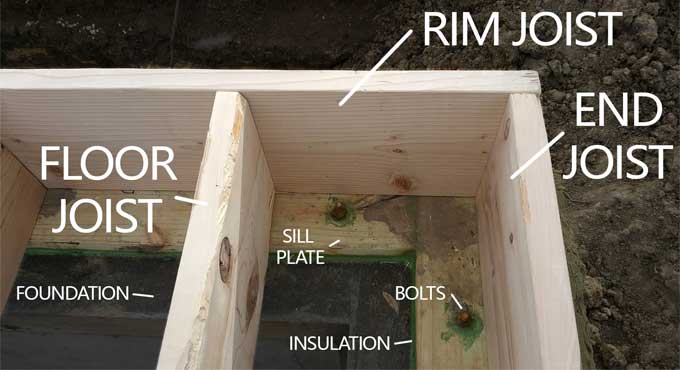
Understanding Rim Joists: Construction, Purpose, Installation, and Their Crucial Role in Construction
In the world of construction, every detail matters, from the foundation to the roof. Among these critical elements is the often-overlooked but indispensable component known as the rim joist. Rim joists play a vital role in the structural integrity, energy efficiency, and overall performance of a building.
In this comprehensive guide, we will delve into the world of rim joists, exploring their construction, purpose, installation, and their profound importance in construction projects.
Deconstructing Rim Joists - What Are They?
Definition and Basics
At its core, a rim joist is a horizontal framing member that runs along the edge of a floor system or at the perimeter of a building's foundation. It forms the outermost part of the floor framing and serves as a crucial connection point between various structural components.
Types of Rim Joists
Rim joists can take various forms, including:
- Solid Wood Rim Joists: Traditional rim joists are often constructed from solid dimensional lumber, such as 2x10s or 2x12s. These provide robust structural support but can be susceptible to moisture-related issues.
- Engineered Rim Joists: Engineered rim joists, often made from laminated veneer lumber (LVL) or engineered wood products, offer improved resistance to moisture, warping, and pests. The use of these materials in modern construction is common.
The Multifaceted Roles of Rim Joists
Rim joists serve a multitude of critical functions in a building, making them an integral part of the construction process.
Structural Support
Rim joists bear the load of the building's exterior walls, transferring it to the foundation. They are essential for maintaining the structural stability and integrity of the entire structure.
Energy Efficiency
Rim joists play a pivotal role in a building's energy efficiency. They act as a barrier against air leakage, preventing drafts and maintaining a consistent indoor temperature. Properly insulated rim joists can lead to substantial energy savings.
Moisture Control
Rim joists are particularly vulnerable to moisture intrusion, which can lead to rot, mould, and other structural issues. Proper construction and insulation techniques are essential for preventing moisture-related problems.
Pest Resistance
Rim joists are susceptible to infestations by pests like termites. Careful selection of materials and preventive measures are necessary to deter these destructive invaders.
Construction and Installation of Rim Joists
Construction Process
Constructing a rim joist involves several key steps:
- Material Selection: Choose appropriate materials, considering factors like structural requirements, moisture resistance, and local building codes.
- Cutting and Framing: Cut the rim joists to the required dimensions and frame them into the floor system, ensuring a secure connection to the floor joists.
Insulation
Insulating rim joists is crucial for energy efficiency. Common insulation materials include fibreglass batts, rigid foam boards, and spray foam insulation. Proper insulation installation helps maintain a comfortable indoor environment and prevents heat loss.
Sealing and Moisture Barrier
To prevent air leakage and moisture intrusion, seal the rim joist area using caulk, foam, or other appropriate sealants. A moisture barrier, such as a waterproof membrane, should also be installed to protect against moisture-related issues.
Practical Uses and Importance in Construction
Foundation Rim Joists
Rim joists are a fundamental component in the construction of the building's foundation. They help create a secure connection between the foundation walls and the rest of the structure, providing stability and load distribution.
Insulation and Energy Efficiency
Rim joists are a critical area for insulation. Properly insulated rim joists can significantly enhance a building's energy efficiency, reducing heating and cooling costs and enhancing occupant comfort.
Structural Integrity
Rim joists play a vital role in maintaining the structural integrity of a building. They distribute loads from exterior walls and upper floors, ensuring the overall stability of the structure.
Moisture and Pest Control
Effective construction and sealing of rim joists are essential to prevent moisture-related issues and pest infestations, which can compromise the durability of the building.
Common Challenges and Best Practices
Understanding rim joists is not without its challenges, and construction professionals must be aware of common issues and best practices.
Moisture Management
Moisture is a significant adversary of rim joists. Implementing moisture management strategies, such as proper flashing and ventilation, is essential to prevent rot and mould growth.
Insulation Techniques
Selecting the right insulation material and installation method is crucial for maximizing energy efficiency. Contractors should be well-versed in the latest insulation techniques.
Compliance with Building Codes and Regulations
Rim joist construction and insulation must adhere to local building codes and regulations. Compliance ensures the safety, energy efficiency, and durability of the structure.
The Future of Rim Joists in Sustainable Construction
As sustainability becomes an increasingly important aspect of construction, the role of rim joists is evolving. Innovations in materials and insulation techniques are making rim joists more energy-efficient and environmentally friendly.
Conclusion
In the intricate world of construction, rim joists may be easily overlooked, but their significance cannot be overstated. From providing structural support to enhancing energy efficiency and moisture control, rim joists are the unsung heroes of every building. Understanding their construction, purpose, and installation techniques is essential for constructing safe, durable, and energy-efficient structures.
To get more details, watch the following video tutorial.
Video Source: Dr. Energy Saver
As construction practices evolve and sustainability takes centre stage, the role of rim joists will continue to evolve, contributing to more resilient and eco-friendly buildings in the future. So, the next time you step into a well-constructed and comfortable building, remember that the humble rim joist played a vital role in making it so.


